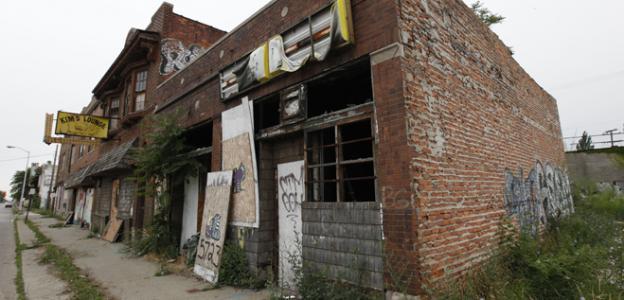Much of bumpy Detroit to get concrete pavement
 |
| Lipstick on a pig. The IndyCar weekend is one of the few things Detroit has going for it. Detroit is a sad example of what you get after 50 years of tax and spend government. All the 'bad' rich people who paid 80% of the taxes left. And the city went bankrupt and will remain bankrupt. Unemployment that was 7.2 percent in 1970, today is a staggering 18.6 percent (it's more like 40% if you count those that gave up looking for a job), far above the national rate of 7.6 percent. Detroit is now the most dangerous big city in America, according to FBI statistics, with a crime rate five times the national average. |
The only thing brighter than the sunshine at Belle Isle was the smile on Bud Denker’s face.
Blessed at last by three perfect days of warm, sunny weather, Denker was beaming at the end of the Chevrolet Detroit Belle Isle Grand Prix.
"I thought it was a pretty darn good weekend," grinned the chairman of the Detroit Grand Prix Association and event patron Roger Penske’s right hand man. "Didn’t the city shine? In isolation, you wouldn’t have known if you were in San Diego, Monaco or Detroit."
He added there was "no doubt" it had been the most successful Detroit GP at Belle Isle as a spectacle and from an organizational standpoint.
Denker, a hands-on event boss often seen pitching in with repairs or improvements to the track and its facilities, expects this year’s race crowd to be up on last year’s rain-affected attendance and one of the biggest since Penske brought the IndyCars back to Belle Isle in 2007.
"I haven’t got attendance figures yet," he said on Sunday evening. "We have to be well over 100,000 for the three days."
Denker believed the turn-out, which reversed last year’s drop to around 95,000 over three days, laid the foundations for the GP to bigger in 2015, when it will again be run on the first weekend of June following the Indianapolis 500.
"I think we’re building a great platform," he said. "I want it to grow. It’s going to be a very easy job for us to sell sponsorship (for next year’s event)."
Denker confirmed that the twin-bill format for the IndyCar Series races – one each on Saturday and Sunday – would be retained following its success since it was introduced last year.
"We’re going to have the Duals back next year," he said. "It’s so important for us, giving us five hours of live TV. Our sponsors want it."
Following Chevrolet’s renewal as the Belle Isle GP’s title sponsor through 2016, Denker will soon start talks with IndyCar for a new multi-year race contract.
He indicated that the Tudor United SportsCar Series, Pirelli World Challenge and Speed Energy Stadium Super Truck Series would return on the support bill.
Denker also announced that the 2.3-mile Belle Isle street course would be upgraded with major resurfacing costing $4 million.
The back straightaway along the river between Turns 6 and 7 will be repaved in concrete, replacing very worn asphalt, and the kink in the middle will be removed, increasing speeds.
A new concrete track surface will also be laid from Turn 11 to the start/finish straight.
The resurfacing work, which is due to begin after the July 4 holiday weekend, will mean that the only section of the track made from asphalt will be the short straightaway in front of the pit lane and through Turn 1 to entry of Turn 2.
According to Denker, the largely Penske Corporation-funded investment in renewing the track was made possible by Chevrolet’s decision to continue as title sponsor for another two years.
"To invest like we’ll be investing, you have to have a plan," he said. "We needed a multi-year agreement to go forward. That two-year commitment gave us the ability to make that investment."
Roger Penske, whose IndyCar team won both Duals at the weekend, bankrolled the grand prix’s return to Belle Isle after a five-year absence in 2007.
The event was suspended after 2008 in the wake of the Global Financial Crisis, but was reinstated with Penske’s continued backing in 2012. Detroit Free Press [How the city of Detroit went bankrupt]
